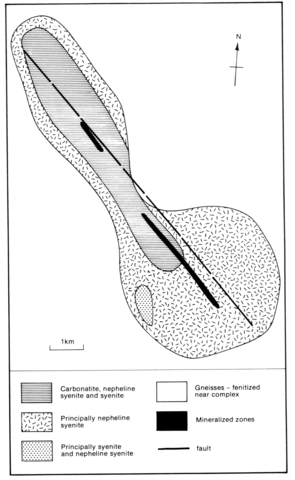stripes
Discovered by airborne radiometry in 1975, the Crevier complex is an elongated body trending northwest-southeast and covering 25 km2. The principal igneous rock types are nepheline syenites and associated nepheline syenite-syenite pegmatites which in a central zone in the northwest are intruded by carbonatite. There is an extensive fenite aureole. Drilling has allowed the complex to be divided into four zones, the first of which in the central northwestern part of the complex comprises 45% carbonate-biotite melasyenite, 26% carbonatite, 26% nepheline syenite and 3% syenite. Contacts between rock types are generally sharp. The second zone, by which the first is generally surrounded, consists of 84% nepheline syenite, 13% carbonate-biotite melasyenite, 2% carbonatite and minor syenite. The nepheline syenite of this zone is a massive rock cut by numerous dykes of the same rock and with many xenoliths of partly digested and fenitized gneiss. The third zone is a small area in the south of the complex consisting of about 53% syenite, 43% nepheline syenite and 3% carbonatite. The last zone is the fenite aureole which extends to 3 km from the complex and is characterized by aegirine in the varied country rock gneisses.
BONNEAU, J. 1981. The Crevier alkaline igneous complex and associated niobium-tantalum-uranium mineralizations. In The St. Honore and Crevier niobium-tantalum deposits and related alkaline complexes, Lac St. Jean, Quebec. Canadian Institute of Mining and Metallurgy. Excursion Guide-Book: 29-35.
HARRISSON, R. 1981. Geochronology, petrography and geochemistry of a section of the Crevier alkaline igneous complex. In The St. Honore and Crevier niobium-tantalum deposits and related alkaline complexes. Canadian Institute of Mining and Metallurgy, Excursion Guidebook: 40.
LAPLANTE, R. 1981. Nb-Ta-U mineralization study from the Crevier alkaline igneous complex, Roberval County, Lac St-Jean, Quebec. In The St. Honore and Crevier niobium-tantalum deposits and related alkaline complexes, Lac St. Jean, Quebec. Canadian Institute of Mining and Metallurgy, Excursion Guide-book: 39.
PERRAULT, G. 1981. A study of the Ta-Nb-U mineralization, Crevier Township, SOQUEM project 10-745. In The St. Honore and Crevier niobium-tantalum deposits and related alkaline complexes, Lac St. Jean Quebec. Canadian Institute of Mining and Metallurgy, Excursion Guidebook: 36.
** GROULIER, P.A., TURLIN, F., ANDRÉ-MAYER, A.-S., OHNENSTETTER, D., CRÉPON, A., BOULVAIS, P., POUJOL, M., ROLLION-BARD, C., ZEH, A., MOUKHSIL, A., SOLGADI, F., EL BASBAS, A. 2020. Silicate-Carbonate Liquid Immiscibility: Insights from the Crevier Alkaline Intrusion (Quebec), Journal of Petrology, 61, 3, egaa033, doi.org/10.1093/petrology/egaa033

